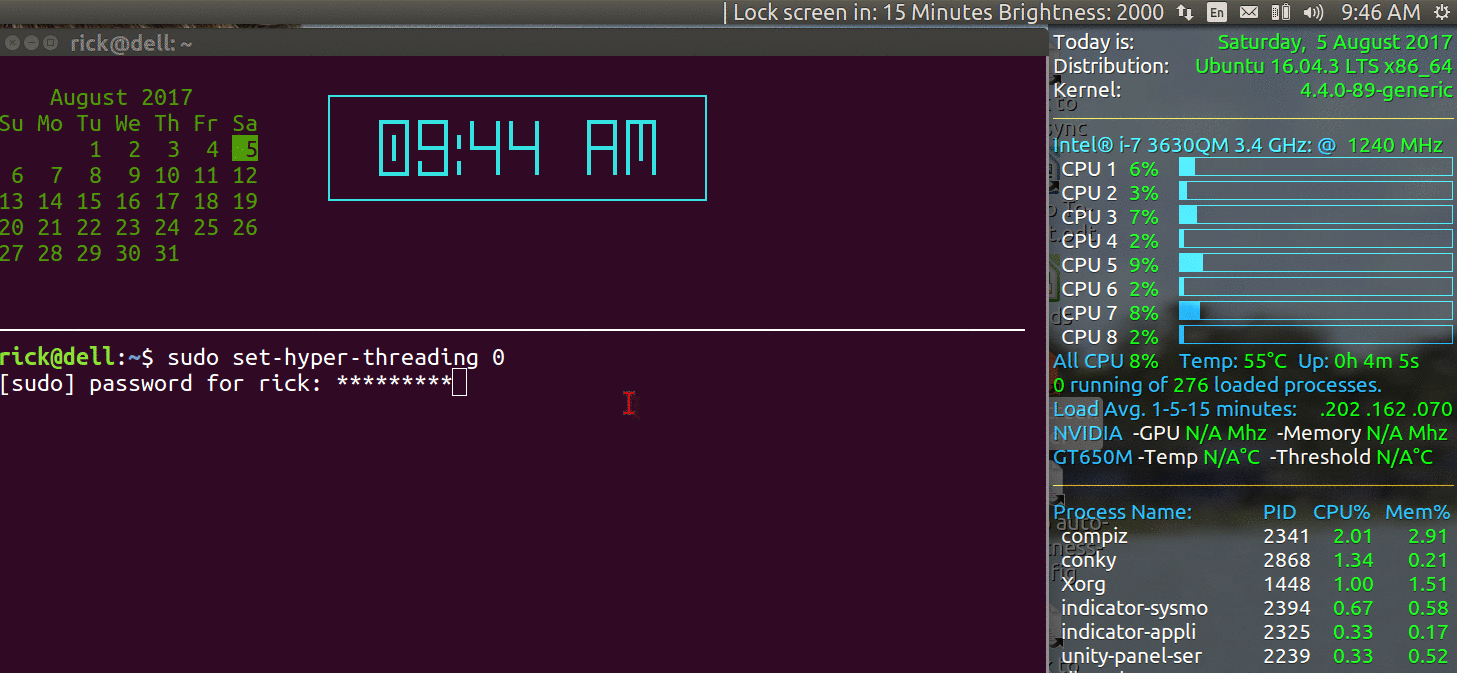Disable hyper threading in Ubuntu
Solution 1
You can disable hyperthreading in Linux as root or with superuser privileges with:
# echo off > /sys/devices/system/cpu/smt/control
You can display the current hyperthreading status with:
$ cat /sys/devices/system/cpu/smt/control
This command prints one of:
on|off|forceoff|notsupported|notimplemented
Alternatively, with recent kernels, you can disable hyperthreading by adding nosmt or nosmt=force to your kernel parameters.
Also, most BIOS firmwares include an option for disabling hyperthreading. If it's disabled in the BIOS the above cat likely returns forceoff.
Solution 2
Introduction
This is an interesting question. Probably one of the most interesting in months for me personally. Like the OP there is no option for disabling Hyper Threading in my old BIOS (invented 2012, updated 2016 or so).
Hyper-Threading bugs in Intel Skylake and Kaby Lake:
Anyone using Intel Skylake or Kaby Lake processors must read the bug reports about Hyper Threading that surfaced a couple months ago. This UK Register story spells out how Debian Developers spotted how Hyper Threading can crash and corrupt the machine.
There are numerous problems with Skylake reported in Ask Ubuntu over the last year and one wonders how to discern which problems may have been caused by Hyper Threading bugs.
This answer is divided into three parts:
- Display of CPUs when Hyper-Threading is turned off/on
- Bash script to automate turning hyper-threading off/on
- Conky Crashes if Hyper Threading is turned off before it starts
Display of CPUs when Hyper-Threading is turned off/on
Below you can see the CPU utilization when hyper-threading is turned off and a CPU stress test is performed. About 10 seconds later the same script is repeated with hyper threading turned on. Finally 10 seconds after that the script is run with hyper-threading turned off again:
The display is divided into two sections:
- On the left half the terminal window invoking the script
set-hyper-threadingwith the parameter 0 (off) and then 1 (on). - On the right half
conkydisplays the CPU percentage utilization of CPUS 1 to 8.
First script run Hyper Threading off
The first time the script is run CPU Numbers 2, 4, 6 & 8 (according to Conky) are frozen at 3%, 2%, 2% and 2%. CPU Numbers 1, 3, 5 and 7 spike to 100% while stress test is run.
The CPU topology is displayed with hyper-threading turned off and only the four cores reported:
/sys/devices/system/cpu/cpu0/topology/core_id:0
/sys/devices/system/cpu/cpu2/topology/core_id:1
/sys/devices/system/cpu/cpu4/topology/core_id:2
/sys/devices/system/cpu/cpu6/topology/core_id:3
Second script run Hyper Threading on
The second time the script is run Hyper-Threading is turned on and all CPU Numbers 1-8 spike to 100% while stress test is run.
The CPU topology is displayed with hyper-threading turned on and only the four cores plus and four virtual cores reported:
/sys/devices/system/cpu/cpu0/topology/core_id:0
/sys/devices/system/cpu/cpu1/topology/core_id:0
/sys/devices/system/cpu/cpu2/topology/core_id:1
/sys/devices/system/cpu/cpu3/topology/core_id:1
/sys/devices/system/cpu/cpu4/topology/core_id:2
/sys/devices/system/cpu/cpu5/topology/core_id:2
/sys/devices/system/cpu/cpu6/topology/core_id:3
/sys/devices/system/cpu/cpu7/topology/core_id:3
Third script run Hyper Threading off
Note how after the second script ends CPUs 2, 4, 6 and 8 are idling at 4%, 2%, 3%, 4%. This is important because in the third test turning Hyper-Threading off shows those CPU percentages frozen at 4%, 2%, 3%, 4% rather than 3%, 2%, 2% and 2% from the first test.
Therefore turning off hyper-threading seems to just freeze the virtual CPUs at the current state.
Also note no matter if you turn Hyper-Threading on or off the script still displays "Hyper Threading Supported".
Bash script to automate turning hyper-threading off/on
When viewing the script below keep in mind that Conky numbers the CPUs from 1 to 8 but Linux numbers the CPUs from 0 to 7.
#!/bin/bash
# NAME: set-hyper-threading
# PATH: /usr/local/bin
# DESC: Turn Hyper threading off or on.
# DATE: Aug. 5, 2017.
# NOTE: Written Part of testing for Ubuntu answer:
# https://askubuntu.com/questions/942728/disable-hyper-threading-in-ubuntu/942843#942843
# PARM: 1="0" turn off hyper threading, "1" turn it on.
if [[ $# -ne 1 ]]; then
echo 'One argument required. 0 to turn off hyper-threading or'
echo '1 to turn hyper-threading back on'
exit 1
fi
echo $1 > /sys/devices/system/cpu/cpu1/online
echo $1 > /sys/devices/system/cpu/cpu3/online
echo $1 > /sys/devices/system/cpu/cpu5/online
echo $1 > /sys/devices/system/cpu/cpu7/online
grep "" /sys/devices/system/cpu/cpu*/topology/core_id
grep -q '^flags.*[[:space:]]ht[[:space:]]' /proc/cpuinfo && \
echo "Hyper-threading is supported"
grep -E 'model|stepping' /proc/cpuinfo | sort -u
stress --cpu 8 --io 1 --vm 1 --vm-bytes 128M --timeout 10s
NOTE: The program stress is built into all Debian systems which Ubuntu is a derivative of. Therefore you don't have to download and install any packages to run this script in Ubuntu.
If you have a dual core CPU you need to remove (or comment out with #) the lines controlling CPU numbers 5 and 7.
Credit to Hi-Angel for bash line grep "" /sys/devices/system/cpu/cpu*/topology/core_id displaying CPU topology.
Conky Crashes if Hyper Threading is turned off before it starts
To get CPUs 2, 4, 6, 8 to lowest percent utilization possible I tried turning off Hyper-Threading during boot up. I used this script to do that:
# NAME: /etc/cron.d/turn-off-hyper-threading
# DATE: Auguust 5, 1017
# DESC: This turns off CPU 1, 3, 5 & 7
# NOTE: Part of testing for Ubuntu answer:
# https://askubuntu.com/questions/942728/disable-hyper-threading-in-ubuntu/942843#942843
# BUGS: Conky crashes with Segmentation Fault when CPU 2,4,6 & 8 (as conky calls them)
# are off-line.
#
SHELL=/bin/sh
PATH=/usr/local/sbin:/usr/local/bin:/sbin:/bin:/usr/sbin:/usr/bin
#
# @reboot root echo 0 > /sys/devices/system/cpu/cpu1/online
# @reboot root echo 0 > /sys/devices/system/cpu/cpu3/online
# @reboot root echo 0 > /sys/devices/system/cpu/cpu5/online
# @reboot root echo 0 > /sys/devices/system/cpu/cpu7/online
However conky crashes with a segmentation fault if hyper-threading is turned off when it starts up. As such I had to comment out the four @reboot lines in the script.
Conky Code to display CPU percent utilization and load factor
If you are interested in setting up a similar display in Conky here is the relevant code snippet:
${color orange}${voffset 2}${hr 1}
${color2}${voffset 5}Intel® i-7 3630QM 3.4 GHz: ${color1}@ ${color green}${freq} MHz
${color}${goto 13}CPU 1 ${goto 81}${color green}${cpu cpu1}% ${goto 131}${color3}${cpubar cpu1 18}
${color}${goto 13}CPU 2 ${goto 81}${color green}${cpu cpu2}% ${goto 131}${color3}${cpubar cpu2 18}
${color}${goto 13}CPU 3 ${goto 81}${color green}${cpu cpu3}% ${goto 131}${color3}${cpubar cpu3 18}
${color}${goto 13}CPU 4 ${goto 81}${color green}${cpu cpu4}% ${goto 131}${color3}${cpubar cpu4 18}
${color}${goto 13}CPU 5 ${goto 81}${color green}${cpu cpu5}% ${goto 131}${color3}${cpubar cpu5 18}
${color}${goto 13}CPU 6 ${goto 81}${color green}${cpu cpu6}% ${goto 131}${color3}${cpubar cpu6 18}
${color}${goto 13}CPU 7 ${goto 81}${color green}${cpu cpu7}% ${goto 131}${color3}${cpubar cpu7 18}
${color}${goto 13}CPU 8 ${goto 81}${color green}${cpu cpu8}% ${goto 131}${color3}${cpubar cpu8 18}
${color1}All CPU ${color green}${cpu}% ${goto 131}${color1}Temp: ${color green}${hwmon 2 temp 1}°C ${goto 250}${color1}Up: ${color green}$uptime
${color green}$running_processes ${color1}running of ${color green}$processes ${color1}loaded processes.
Load Avg. 1-5-15 minutes: ${alignr}${color green}${execpi .001 (awk '{printf "%s/", $1}' /proc/loadavg; grep -c processor /proc/cpuinfo;) | bc -l | cut -c1-4} ${execpi .001 (awk '{printf "%s/", $2}' /proc/loadavg; grep -c processor /proc/cpuinfo;) | bc -l | cut -c1-4} ${execpi .001 (awk '{printf "%s/", $3}' /proc/loadavg; grep -c processor /proc/cpuinfo;) | bc -l | cut -c1-4}
${color1}NVIDIA ${color}-GPU ${color green}${nvidia gpufreq} Mhz ${color}-Memory ${color green}${nvidia memfreq} Mhz
${color1}GT650M ${color}-Temp ${color green}${nvidia temp}°C ${color}-Threshold ${color green}${nvidia threshold}°C
${color orange}${voffset 2}${hr 1}
NOTE: The full conky resource file can be found on this answer.
Solution 3
Recent kernels support the maxcpus kernel parameter.
This allows you to set the number of cpus to the number of physical cores. This may be useful to help mitigate threats caused by MDS vulnerabilities on Intel CPUs from family 6.
How:
with sudo (root) privileges open /etc/default/grub with your favorite text editor.
Find the line that begins with GRUB_CMDLINE_LINUX_DEFAULT=
and add maxcpus=n to any existing kernel parameters such as the common quiet splash parameters (where n = the number of physical cores your cpu has.
For example on my trusty Intel(R) Core(TM) i3-3220 CPU @ 3.30GHz dual core with hyperthreading I added maxcpus=2 to turn off hyperthreading at boot time.
Save the file and then issue the command sudo update-grub and reboot.
You can confirm success by issuing the command lscpu | grep "per core" which should provide output like this:
Thread(s) per core: 1
Tested on kernel 4.4.0
Sources:
https://github.com/torvalds/linux/blob/master/Documentation/admin-guide/kernel-parameters.txt
https://www.kernel.org/doc/html/latest/admin-guide/hw-vuln/mds.html
https://unix.stackexchange.com/questions/145645/disabling-cpu-cores-on-quad-core-processor-on-linux
Solution 4
Here is a script to identify the ht-cores and toggle them online/offline.
#!/bin/bash
typeset -i core_id
typeset -i sibling_id
typeset -i state
for i in /sys/devices/system/cpu/cpu[0-9]*; do
core_id="${i##*cpu}"
sibling_id="-1"
if [ -f ${i}/topology/thread_siblings_list ]; then
sibling_id="$(cut -d',' -f1 ${i}/topology/thread_siblings_list)"
fi
if [ $core_id -ne $sibling_id ]; then
state="$(<${i}/online)"
echo -n "$((1-state))" > "${i}/online"
echo "switched ${i}/online to $((1-state))"
fi
done
@WinEunuuchs2Unix, maybe you can add this to your excellent answer.
Solution 5
The maxcpus=n parameter in GRUB_CMDLINE_LINUX_DEFAULT= doesn't work properly. It left me with 2 cores and 4 threads instead of 4 cores 4 threads.
I found a solution.
Add mitigations=auto,nosmt to GRUB_CMDLINE_LINUX_DEFAULT= instead
Tested on Ubuntu 16.04 LTS with Linux 4.4.0.
Source: https://wiki.ubuntu.com/SecurityTeam/KnowledgeBase/MDS
john
Updated on September 18, 2022Comments
-
john over 1 year
I am running ubuntu 16.04 server. I can see that hype threading is enabled when I use the lscpu command.
I want to disable it . I went through ubuntu forums and here and here.
These are good discussions why hyper threading may may- not be good. But no definitive solution on how to turn it off.
Can any give the steps for disabling hyperthreading ? Thanks .
-
 edwinksl over 6 yearsHave you tried disabling it in the BIOS?
edwinksl over 6 yearsHave you tried disabling it in the BIOS? -
john over 6 yearsyes, could not find an option for HT
-
france1 almost 3 years@MobTactics: It is much more easy! Just add ht=off except your things to disable hyperthreading.
-
-
 Hi-Angel over 6 yearsSorry, but
Hi-Angel over 6 yearsSorry, butnohtdoesn't exist. I even grepped for the option through linux-4.13-rc1 sources that I happen to occasionally have. However I certainly understand what could've confused you: dat bugreport complains that the option doesn't work, and then it's closed asnextrelease, like if they fixed something. However if you read the comments, you'll see that the only use ofnohtis for a hand-crafted script which checks the kernel command line for the option, then disables cores through/sys/filesystem. IOWnohtis useless. -
 WinEunuuchs2Unix over 6 years@Hi-Angel Thanks for pointing out it's not necessary. I did testing without it and the off-line cores doubled from 2,2,5,5 % (with noht) to 5,5,10,10% (without noht). I'll do more testing tonight. I searched kernel parameter documentation and could not find any reference to
WinEunuuchs2Unix over 6 years@Hi-Angel Thanks for pointing out it's not necessary. I did testing without it and the off-line cores doubled from 2,2,5,5 % (with noht) to 5,5,10,10% (without noht). I'll do more testing tonight. I searched kernel parameter documentation and could not find any reference tonoht. -
 Hi-Angel over 6 yearsOn side note, there's no Machine/Human language to indexing :) To resolve confusion with indices starting from 0, 1, or even a particular number (as it is in MiniZinc), it's better to think in terms of index sets, i.e. a surjection from a set of indices to another set. Abstracting it away allows you to note easier when some relevant to a data stuff, that does not represent indices, can actually be used for indexing after getting twiddled a bit. The advantage comes from having in mind a concept unbound from a memory layout and other limitations.
Hi-Angel over 6 yearsOn side note, there's no Machine/Human language to indexing :) To resolve confusion with indices starting from 0, 1, or even a particular number (as it is in MiniZinc), it's better to think in terms of index sets, i.e. a surjection from a set of indices to another set. Abstracting it away allows you to note easier when some relevant to a data stuff, that does not represent indices, can actually be used for indexing after getting twiddled a bit. The advantage comes from having in mind a concept unbound from a memory layout and other limitations. -
 WinEunuuchs2Unix over 6 years@Hi-Angel Similar comparison between "Start Position" and "Offset" I guess. Anyway I'm about to rewrite this answer based on last two days of testing and coding so our comments will soon be obsolete...
WinEunuuchs2Unix over 6 years@Hi-Angel Similar comparison between "Start Position" and "Offset" I guess. Anyway I'm about to rewrite this answer based on last two days of testing and coding so our comments will soon be obsolete... -
 WinEunuuchs2Unix almost 5 yearsInteresting links. Thanks for sharing.
WinEunuuchs2Unix almost 5 yearsInteresting links. Thanks for sharing. -
 Elder Geek almost 5 years@WinEunuuchs2Unix My pleasure. Always eager to help!
Elder Geek almost 5 years@WinEunuuchs2Unix My pleasure. Always eager to help! -
 neuhaus almost 5 yearsI had to numerically sort the list to make it work properly:
neuhaus almost 5 yearsI had to numerically sort the list to make it work properly:for i in $(find /sys/devices/system/cpu/cpu[0-9]* -maxdepth 0 -type d |sort -V); do -
 Elder Geek over 4 yearsHave you tried this to disable hyper threading at boot?
Elder Geek over 4 yearsHave you tried this to disable hyper threading at boot? -
 Elder Geek over 4 yearsDoes this method work on your Ryzen CPU?
Elder Geek over 4 yearsDoes this method work on your Ryzen CPU? -
maxschlepzig over 4 years@ElderGeek no, I haven't tried the
maxcpus=kernel parameter for disabling hyperthreading. Mainly because I can't find any official documentation on its interaction with hyperthreading cores. Is it guaranteed to always disable hyperthreading if you specifymaxcpus=#real_cores? Or might you end up with half the real-cores with HT still enabled on some systems? Also onemaxcpus=setting isn't portable between machines with different core counts. Maintaining variations of this parameter for different machines would be tedious and error-prone. -
 Elder Geek over 4 yearsIn my experience is has always disabled hyperthreading if you specify maxcpus=#real_cores provided of course that you trust the output of
Elder Geek over 4 yearsIn my experience is has always disabled hyperthreading if you specify maxcpus=#real_cores provided of course that you trust the output oflscpu | grep "per core"You make a vaild point regarding portability however, on the flip side setting the kernel parameter once doesn't seem too onerous a task to me. -
Diagon about 4 yearsRick - what's that cool terminal based calendar you've got running there??
-
 WinEunuuchs2Unix about 4 years@Diagon Just type in
WinEunuuchs2Unix about 4 years@Diagon Just type incal. See: Is there a command to display a Calendar in the terminal? and Terminal splash screen with Weather, Calendar, Time & Sysinfo? -
Diagon about 4 yearsThanks, but I was really asking about that overlaid clock (9:44 AM), which I thought was part of the same program, but maybe not.
-
 WinEunuuchs2Unix about 4 years@Diagon It's just the bash command
WinEunuuchs2Unix about 4 years@Diagon It's just the bash commandecho " $(date +"%I:%M %P") "piped throughtoiletcommand to make it bigger in a fancy font. You can post questions about it on the second link. -
 doraemon over 2 years@WinEunuuchs2Unix how to use
doraemon over 2 years@WinEunuuchs2Unix how to useconkyand your snippet? I triedconky -cand does not work -
 WinEunuuchs2Unix over 2 years@doraemon I've updated the answer with a link to the full conky resource file. You can't run just a snippet.
WinEunuuchs2Unix over 2 years@doraemon I've updated the answer with a link to the full conky resource file. You can't run just a snippet.
